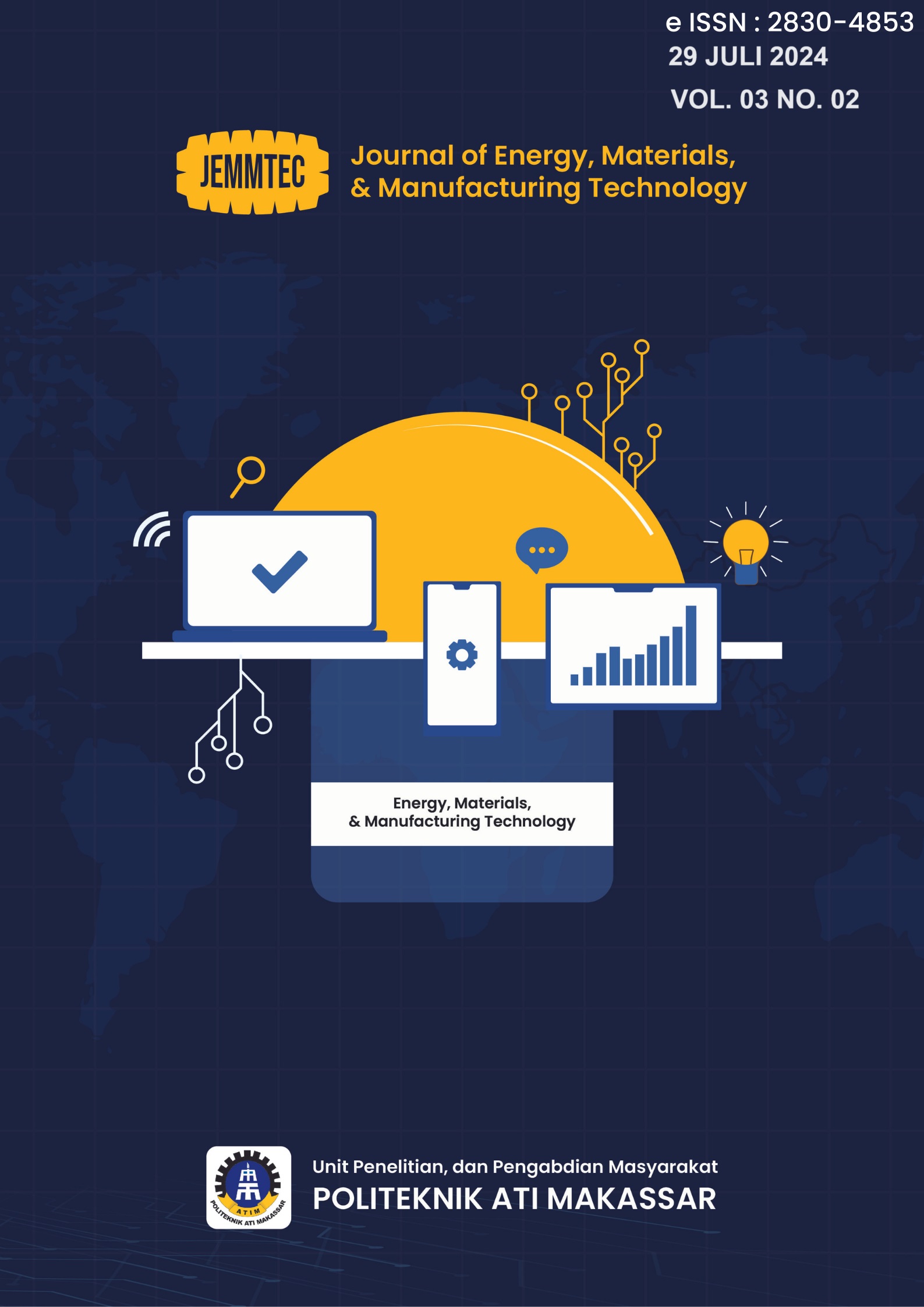Pengembangan Pengembangan Sistem Monitoring Kelembapan dan Suhu pada Penyimpanan Gudang Loofah dengan Penggunaan Humidifier
DOI:
https://doi.org/10.61844/jemmtec.v3i02.767Keywords:
Sistem monitoring, kelembapan, suhu, gudang loofah, humidifierAbstract
This study aims to develop a humidity and temperature monitoring system for loofah warehouse storage using a humidifier to maintain storage environment stability. The research method includes needs analysis, system design, implementation, and testing. The system design includes temperature and humidity sensors connected to an Arduino microcontroller, which controls the humidifier to maintain temperature and humidity within the desired range. Testing was conducted under warehouse simulation conditions with temperature and humidity variations, as well as in actual loofah warehouses. The research findings indicate that the developed monitoring system is capable of maintaining temperature and humidity levels within the loofah warehouse at the desired level. Implementing this system can help optimize loofah storage conditions, reduce product damage, and improve storage efficiency.
References
J. Chen and J. Xiao, “Design of intelligent temperature and humidity monitoring system based on STM32,” J. Phys. Conf. Ser., vol. 2493, no. 1, 2023, doi: 10.1088/1742-6596/2493/1/012002.
K. J. Shamang, M. I. Chukwuma-Uchegbu, and A. Sa’id El-nafaty, “Indoor Temperature and Humidity Monitoring System,” J. Sci. Eng. Technol. Manag., vol. 02, no. 05, pp. 50–58, 2020, doi: 10.46820/jsetm.2020.2503.
M. F. Awaj, A. F. Rochim, and E. D. Widianto, “Sistem Pengukur Suhu dan Kelembaban Ruang Server,” J. Teknol. dan Sist. Komput., vol. 2, no. 1, p. 40, 2014, doi: 10.14710/jtsiskom.2.1.2014.40-47.
X. Wei, “Research on Condition Monitoring of Transformer Respirator Based on Temperature and Humidity Sensing and Visual Judgment,” vol. 0, 2023, doi: 10.3233/atde230303.
K. Anam, D. N. Rofi, and R. Meiyanti, “Monitoring System for Temperature and Humidity Sensors in the Production Room Using Node-Red as the Backend and Grafana as the Frontend,” J. Syst. Eng. Inf. Technol., vol. 2, no. 2, pp. 68–76, 2023, doi: 10.29207/joseit.v2i2.5222.
R. J. Syahputra, M. Sihombing, and D. Saripurna, “Journal of Artificial Intelligence and Engineering Applications Monitoring The Temperature And Humidity Air In The Room Using A Sensor IoT-Based DHT-11,” vol. 3, no. 1, pp. 2808–4519, 2023, [Online]. Available: https://ioinformatic.org/.
M. A. Falahuddin and P. N. Bandung, “Implementation of the Lora System for Temperature and Humidity Monitoring in POLBAN Classrooms,” vol. 15, no. 2, pp. 35–42, 2023.
R. Chotikunnan, P. Chotikunnan, P. Imura, and M. Sangworasil, “Robotic Arm Design and Control Using MATLAB / Simulink Robotic Arm Design and Control Using MATLAB / Simulink,” no. September, 2023, doi: 10.15379/ijmst.v10i3.1974.
F. Robbika et al., “Rancang Bangun Prototipe Alat Pengukuran Suhu Kerut Kulit Tersamak Analog,” pp. 31–40, 2024.
A. B. Setyawan, M. Hannats, and G. E. Setyawan, “Sistem Monitoring Kelembaban Tanah, Kelembaban Udara, Dan Suhu Pada Lahan Pertanian Menggunakan Protokol MQTT,” J. Pengemb. Teknol. Inf. dan Ilmu Komput. Univ. Brawijaya, vol. 2, no. 12, pp. 7502–7508, 2018.
B. Ananto Pamungkas, A. Fatchur Rochim, and E. Didik Widianto, “Perancangan Jaringan Sensor Terdistribusi untuk Pengaturan Suhu, Kelembaban dan Intensitas Cahaya,” J. Teknol. dan Sist. Komput., vol. 1, no. 2, p. 42, 2013, doi: 10.14710/jtsiskom.1.2.2013.42-48.
M. N. Adlini, A. H. Dinda, S. Yulinda, O. Chotimah, and S. J. Merliyana, “Metode Penelitian Kualitatif Studi Pustaka,” Edumaspul J. Pendidik., vol. 6, no. 1, pp. 974–980, 2022, doi: 10.33487/edumaspul.v6i1.3394.
H. Wang, A. Takano, and K. Tamura, “An attempt to create the holistic flow chart of forest resources,” IOP Conf. Ser. Earth Environ. Sci., vol. 588, no. 4, 2020, doi: 10.1088/1755-1315/588/4/042039.








